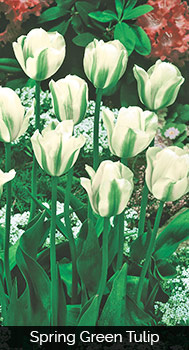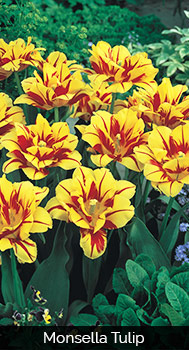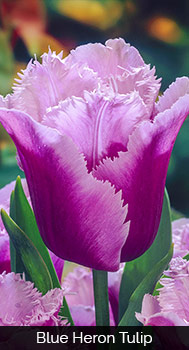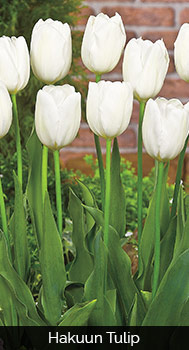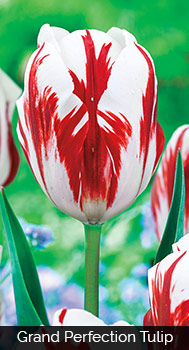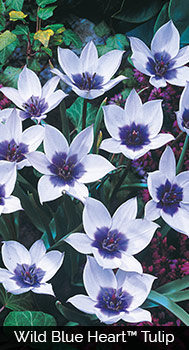Beautiful, jewellike, ephemeral — the tulip has been an object of passion for centuries.
The first Tulips grew wild in the area now known as Kazakhstan, and they spread east across Asia and west toward the Mediterranean. It took humans, though, to move them north of the Alps. It isn’t known who brought the first tulips to Western Europe from Turkey, though we do know it was during the reign of the Ottoman Emperor Suleiman the Magnificent (1520-1566). They were first grown in Bavaria around 1559. Botanist Charles de I’Ecluse, a.k.a. Clusius, brought tulips with him to Holland when he took a teaching position at the University of Leiden in 1593.
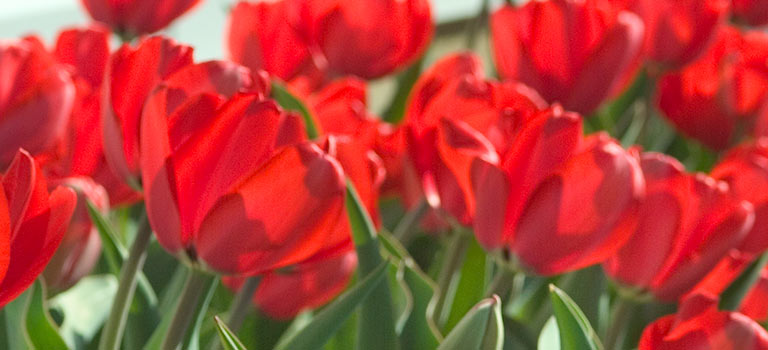
To Learn More:
The definitive resource is the aptly named book, The Tulip: The Story of a Flower That Has Made Men Mad by = Anna Pavord. (Bloomsbury, POEM new edition 2004)
Did You Know?
The word “tulip” comes from the Turkish word for turban. This might be because of the similarity in shape, or it might refer to the fact that Turks at the time would wear tulips tucked into their turbans for adornment.
A passion for fashion
‘Tulips hybridize well, so breeders have responded to changing fashions in shapes and colors. The Ottoman Turks, for instance, preferred an exaggeratedly slender shape, with each petal having a daggerlike appearance. Western Europeans — and after them, Americans — prefer rounder shapes, including “cups” (round at the bottom but with straight sides) and “bowls” (rounded and full like a half globe.)
Types of Tulips
 Planting tulips
Planting tulips
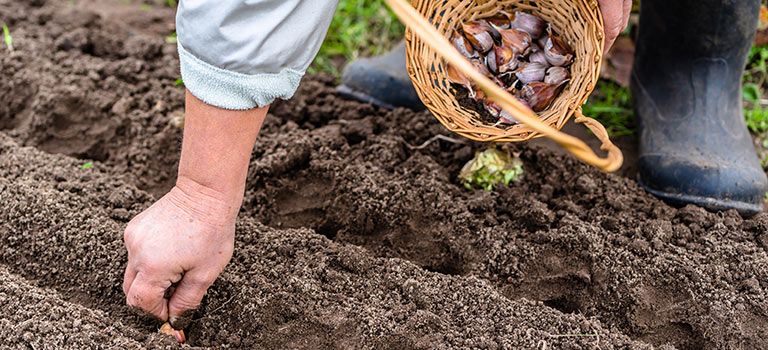 Tulips prefer part to full sun. Soil should be well aerated and well drained, slightly acidic (pH 6-7), and cultivated to a depth of 8-12″. These spring favorites require a cool period of dormancy before they’ll bloom. In colder Northern climates, plant bulbs in October and let Mother Nature take care of the cooling. In the South, provide the cooling period by placing bulbs in a refrigerator at 40-45°F for 6-8 weeks (or up to 16 weeks if necessary) and plant them by early January. Don’t store apples or other fruit near the bulbs, though — as it ripens, the fruit gives off ethylene gas that will kill the young buds stored inside the bulbs.
Tulips prefer part to full sun. Soil should be well aerated and well drained, slightly acidic (pH 6-7), and cultivated to a depth of 8-12″. These spring favorites require a cool period of dormancy before they’ll bloom. In colder Northern climates, plant bulbs in October and let Mother Nature take care of the cooling. In the South, provide the cooling period by placing bulbs in a refrigerator at 40-45°F for 6-8 weeks (or up to 16 weeks if necessary) and plant them by early January. Don’t store apples or other fruit near the bulbs, though — as it ripens, the fruit gives off ethylene gas that will kill the young buds stored inside the bulbs.
Plant with the pointy end facing skyward, and the rounded bottom of the bulb 6″ deep; if they’re planted deeper, they are apt to rot. Bulbs should be 3-6″ apart. Rather than digging each hole individually, you can dig trenches for long swaths of color. If you do want small clusters of flowers, you can get a special gardening awl attachment for your power drill to dig each hole.

Fill in the holes, then fertilize with a product designed for bulbs, like Breck’s Food for Bulbs and Perennials. Water them to ensure strong root development. (You will fertilize them again in the spring, when the first shoots begin to appear.) Finish by covering your bulbs with a 2-3″ mulch layer of compost, leaves, or straw.

Tulips reproduce slowly and unreliably in the home garden (see page 37), so they were prized as precious collectibles. Their rarity and jewellike beauty made them especially appropriate for tiny Dutch gardens, where individual specimens, rather than mass plantings, were the rule.
Breaking News
There was one oddity about tulips, though: Growers found that the “daughter” bulbs they planted might or might not look like their “mother” bulb. In a bed of a hundred tulips, one or two might spontaneously “break” into subtle, gorgeous streaks and stripes of different colors. These “broken” tulips appeared mysteriously and were much prized by connoisseurs.
No one knew then what caused breaking, so growers tried many different techniques to encourage it. They sprinkled dye on beds of white bulbs, or mixed various additives — pigeon droppings and plaster from old houses were both popular — into the soil. Some growers tried tying together mismatched halves of bulbs of different colors. Nobody could reliably produce the dazzling broken tulips, though, so growers had to wait until one presented itself. When it did, its daughter bulbs tended to be small and weak, and wouldn’t necessarily grow to blooming size. Thus the broken lines tended to die out quickly — making them all the rarer.
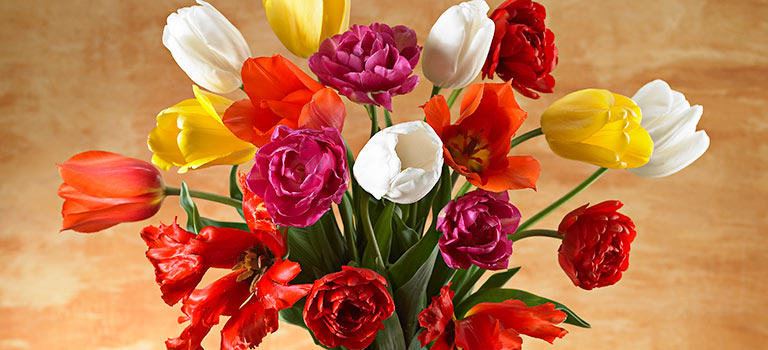
This is the basis of Tulipmania, the frenzy for buying and selling tulip bulbs that swept Holland during the early part of the 1600s. In 1623, one bulb of the variety “Semper Augustus’ (a broken tulip with red and white streaks) went for about 1,000 florins — at a time when the average yearly income was 150 florins. Prices just continued to rise.
Crazy? Perhaps, but not according to the “greater fool theory”: paying a crazy price for something isn’t actually crazy if you can rely on someone else (a “greater fool”) buying it from you at an even higher price.
And until the 1630s, there always seemed to be a greater fool available. In 1637, however, the bubble burst. A set of bulbs was put up for auction — and nobody bid. The market collapsed, and the fever of Tulipmania broke.
After The Fall
Despite a brief backlash, tulips remained popular — and pricey, though not foolishly so. Breeding and trading continued, as did efforts to force tulips to break. It wasn’t until the 1920s, though, that the cause of breaking was discovered: a virus, carried by the peach potato aphid. The gorgeous streaking and feathering of a broken tulip is a sign that the plant is diseased, and the weakness and small size of its offset bulbs a secondary result. Once this disease was identified, efforts were taken to eradicate it, and the growing and sale of virus-ridden tulips outlawed.
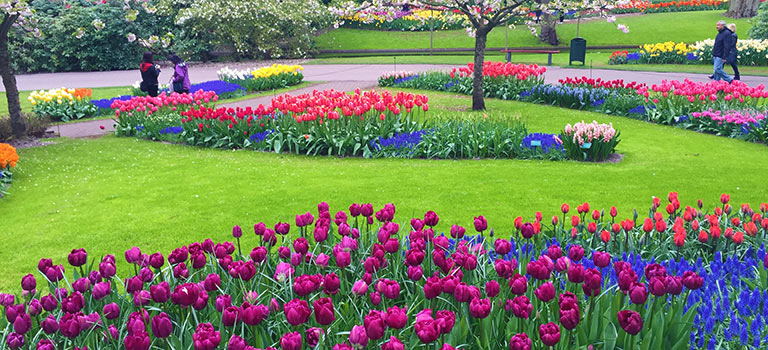
Today, one special garden, the Hortus Bulborum in Limmen, Holland, still grows true virus-broken bulbs under controlled conditions. Their beauty and diversity is breathtaking, but they’re too dangerous to grow commercially. Instead, the “Rembrandt” tulips sold today are disease free, and get their gorgeous streaked appearance from the careful breeding of healthy stock.
The rich history of the tulip is matched by its rich beauty. The flowers have a quality that no painting or photo can ever adequately capture.
The Return of the Tulip
‘Tulips are bulbs, and bulbs come back every year, right?
Well, right and wrong. Tulips are bulbs, so each has a flower fully formed in the center of the bulb at the time of planting. After spring bloom, the foliage creates food that is stored in the bulb to fuel the next year’s growth. That growth will not, however, be only in the ‘mother” bulb that just grew, but also in smaller “daughter” bulbs that form around it. These offspring may take a few seasons to reach blooming maturity — or they may not survive that long.
Thus, tulips cannot be relied on to replace themselves year after year. Dutch home gardeners generally treat them as annuals — they pull them up and discard them when the bloom is done, and replant a new batch of bulbs each fall. This will appeal to those who delight in always trying something new: new cultivars, new colors, new combinations.
Of course, you don’t have to pull up and discard your tulips when they’re done blooming. You can accept their limited lifespan — and also leave your bulbs in the ground and regard any return appearance as a delightful bonus. If you take this tack, there are a few things you can do to increase the likelihood of a repeat performance.
Some types of tulips are more reliable as multi-season performers than others, so choose a type that is apt to come back. Darwin hybrids, which many people love for their large blooms and bright colors, are among these. At the opposite end of the appearance spectrum are the Greigii tulips, which tend to be smaller and more “wild” looking, with wavy-margined, striped leaves.
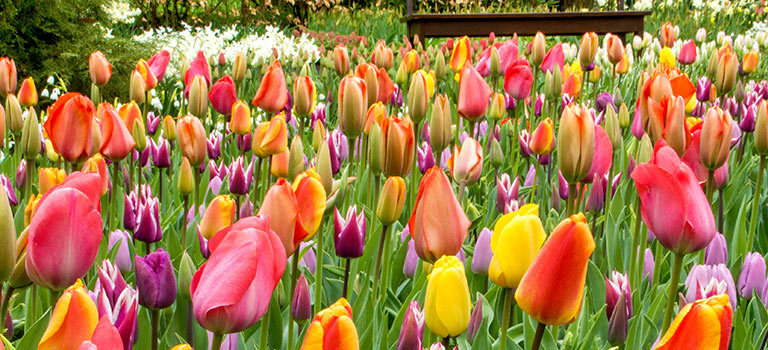
Tulips originally came from a dry, mountainous area east of the Caspian Sea, and they grow wild mostly around the Mediterranean and in places with hot, dry summers and poor soil. Thus, one of the main reasons tulips don’t return to well-watered American gardens is that they’ve rotted in the ground. Plant them in a well-drained area, preferably in a dry, sunny bed where you don’t do much supplemental watering in the summer. Also, give them elbow room: Don’t interplant with densely rooted perennials, like daylilies.
In order to give the daughter bulbs as much help as possible, fertilize them twice a year, in the spring (when the shoots first emerge) and again in October (when you’re putting in any new bulbs). It’s okay to water them at these two times, as well. Of course, this is in addition to letting the foliage do its job: feeding the bulb. After flowering, leave the foliage intact (you can cut off the flower and stem) until it has completely died back. Don’t cut it, tie it, or do anything to interfere with it.
If you follow these guidelines, you will improve the chances that your tulips will be back next year.


